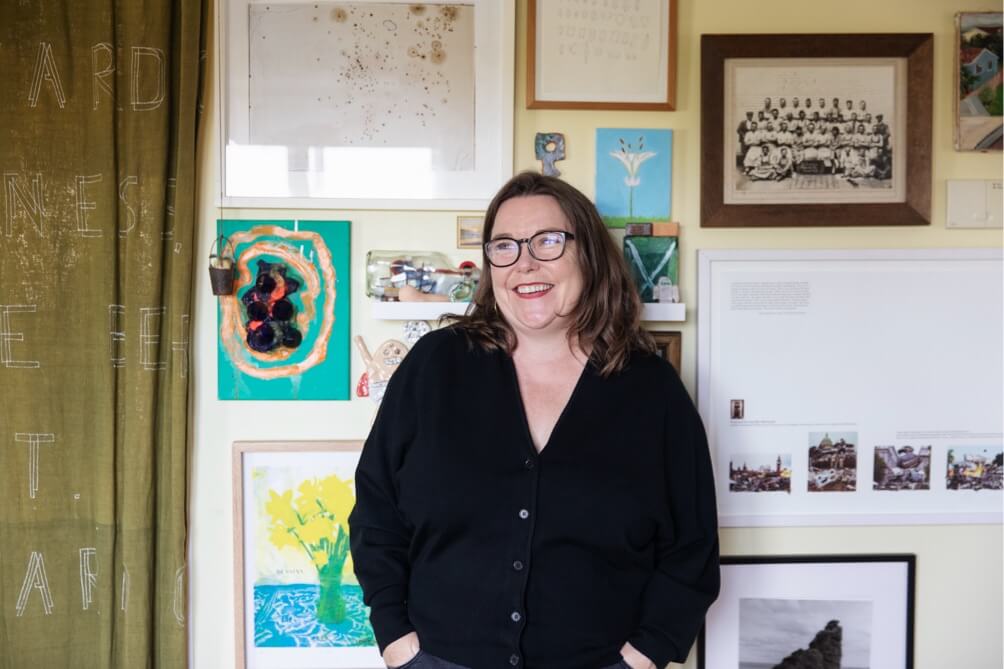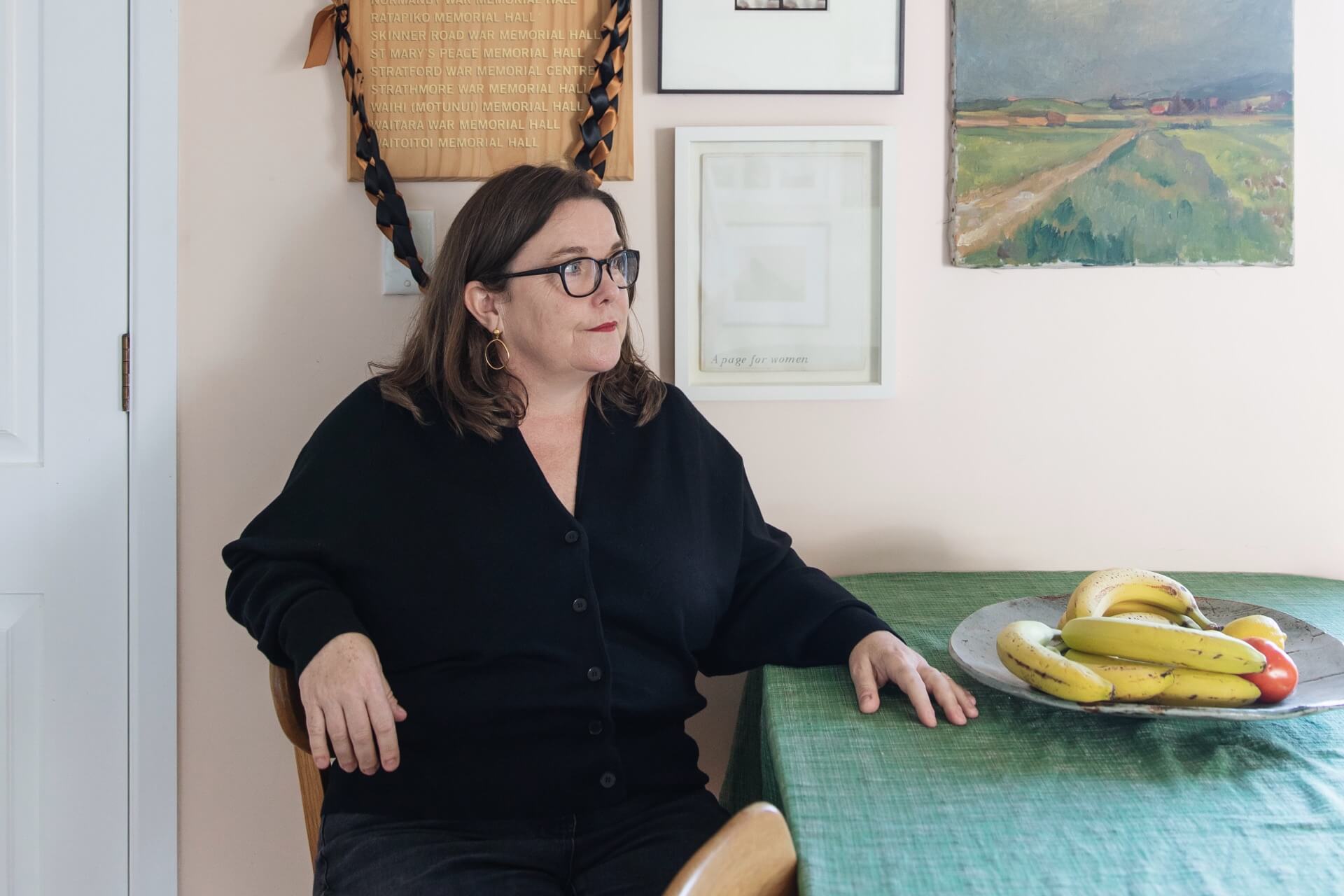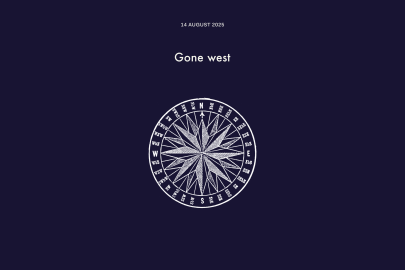Jun 12, 2023 Art
Fiona Jack, artist and lecturer at Elam, the University of Auckland’s School of Fine Arts, has recently been appointed its head — the first woman to hold the role in the institution’s 133-year history. Jack comes to the position with a multidisciplinary body of artistic and academic work behind her; she may be the ideal person to oversee potentially controversial changes in the school’s operation. This is not a career plateau for her by any means.
Jack’s work is mostly recognisable as conceptual — or has been at various points in her career. “I have at times called myself a conceptualist, because that used to be the easiest way to capture a responsive, ideas-driven practice. A connection to society and people and places is more how I would think about it these days… I used to call it digressive research, that I was willing to start with the total knowledge that I would be swayed like the trees in any direction.”
A refusal — or inability — to lock into a set mode of working is exactly what equips Jack for Elam’s head role. She initially did a design degree at AUT and taught design there for a number of years, then got a Master of Fine Arts from CalArts in California. In 2007, she was offered a role lecturing at Elam and has been there ever since. As well as bringing a breadth of experience to the table, Jack has a self-styled improvisational approach. Which isn’t to say someone with more specialised interests and practices couldn’t do the job, only that Jack’s relative openness as an artist brings a pluralistic perspective to the university’s recent mergings of departments, which has given fine arts increased proximity to other disciplines and departments.
“A lot of people move between fine arts, design and architecture, and the university has just done a recruitment video in that knowledge,” Jack says. “Basically, they gathered the heads of the schools to unpack the differences for a student who is trying to make that decision. I would’ve loved to have had that when I was a kid.”
That Elam has never before officially appointed a woman to its top job is of course indicative of historic bias, but the fact remains startling. There have been other women leaders in fine arts, Jack tells me, mentioning Carole Shepheard, who was the acting head of Elam in the late 1990s (and also, incidentally, only the second woman professor of fine arts in the country), and Nuala Gregory, another acting head, who is currently the dean overseeing the areas of fine arts and design, architecture and planning, and music and dance. “We have a painter as the dean of our faculty!” Jack exclaims with obvious pleasure.
To reference an idea by feminist scholar Camille Paglia (from convenience, not from any intellectual fealty to this controversial academic), there is an inevitable lag between institutions and the services they offer and the actual needs of people in their lived lives. This is not to apologise for the systematic exclusion of women from positions of authority, but to point out that institutions represent snapshots in time and reify existing social conditions, practically entrenching them. Naturally, extensive overhaul to keep up with the shifting expectations of the contemporary takes time. As Paglia expresses in the essay collection Free Women, Free Men (2017), having patience and being persistent in the reshaping of our foundational institutions might be preferable to the often short-term and performative resistances of youth, a time when we first encounter the world around us and flush bloody with its boundless inventory of atrocities. We may stridently criticise the shortcomings of institutions but shouldn’t forget the treasures and resources that they stockpile. Negotiating redistribution of these resources along more expansive lines should be the priority — of more practical importance than the most incendiary impulses of today’s justice-minded (or embittered) rhetoricians.
One might ask, then, why and how a fine arts education is relevant. Or ask, as we navigate the increasingly necrotic conditions of our city (straining under the divisions of Covid-19, inequality and the consequences of climate change): how does the university’s fine arts school qualify as a profitable institution worthy of the resources sustaining it?

Fiona Jack
“In conversation with parents whose children are considering coming here,” Jack tells me, “the question I get is ‘Why art?’ And I generally say, ‘Well, look, one of the things art education does is help people to be well and happy as makers. But also, a little-known fact about arts education is it creates critically strong thinkers. People who can really understand context and situation and who can critique an aspect of something from many different perspectives. And that is an incredible life skill, and one that’s very transferable. So I feel deeply passionate that art education is important for a well society, from primary school right through to tertiary levels.”
As with the humanities more broadly, the contributions of ‘the arts’ are often too nuanced to measure in any quantifiable way, especially as the metrics we might use are steeped in economics and anti-humanist accounts of individuals-as-content-creators. The sciences and the vertiginous leaps and bounds of technology are often deemed to be society’s legitimate motor; many forget that critical thinking is not site-specific — that it can and should exist continuously between the disciplines, and that it should and does stimulate innovation. Not just innovation as economic opportunity, but a type of critical innovation. The arts offer us space for interdisciplinary course corrections — and without taking this space and making these changes, we will be ill-equipped to deal with the ever-increasing social and ecological volatility occasioned by our tunnel-visioned missteps.
There has, of course, been push back against the university’s pressure on Elam to be absorbed. Back in 2018, facing the closure of the Fine Arts Library, Elam students assembled in protest, occupying the space ahead of the scheduled shutting of its doors. Long story short, these well-meaning efforts failed to make a dent in the wider university’s firm decision. Some of the discourse around protecting the library was also about Elam resisting co-option by disciplines with more self-evidently practical applications, like architecture and design. Many felt that, along with this space for critical thinking, the school’s relative independence would be lost.
The library’s closure was not an isolated instance, but part of a wider trend of universities worldwide upscaling their commercial appeal and downsizing enclaves dedicated to free thought (a concept appropriately symbolised in the meandering fruitfulness of a browsable library). Such spaces had become less desirable for a lack of immediate returns. In response art students established their own space off site: Samoa House Library, on Karangahape Rd. The initiative sought to provide not just a replacement library, but a space for discourse they felt the university was lacking in, or would be with the pending closure. The independent library had initially hoped to inherit books from the university fine arts collection, but for now these books remain in storage, issued through the main university library by request only.
Jack arrives to our talk with the reality of ‘absorption’ laid out for me: long-game mergers of the separate schools finessed into concrete overlapping curricula. Despite the warranted concern of the students enrolled, many of whom protested when these plans were mere rumbles, Jack seems confident the new approach can bring more good than bad. Certainly, an allegiance to interdisciplinary ways of thinking has never stopped Jack from being critical, specifically of the more commercial area of design which her first degree is in.
“I was a bit belligerent in my design degree,” she says. “I refused to do logos. I took my own path and I made a lot of street posters, using these as my graphic form. I developed a relationship with Bill Stickers which I guess was the predecessor to Phantom Bill Stickers. This was back when there were no commercial poster sites, there were just walls around the city. And I’d do posters and they’d put them up for free for me, because they liked what I was doing.”
Jack began her study of design, ironically, only after her Elam application was rejected.
“I didn’t get in, and my students laugh when I tell them. I think it’s a good story to tell because I didn’t let that stop me. I think not letting disappointment and rejection stop you is the story of being an artist.”
After she graduated from AUT, Jack was awarded a fellowship, giving her access to the university’s resources for a year as well as a stipend. She started thinking bigger than posters: billboards.
“There was no expectation on me, but I wanted to make a big project and so I thought, ‘I’ll get one billboard’. I drew a mock-up and I took it to this guy Gordon Frykberg who owned the billboard company OGGI. And I said, ‘Look, I’ve got this idea and I’d really love to make this billboard. Is there any chance you would let me do it?’ And it was crazy because billboards were a new thing in Auckland at that time, or in New Zealand really, and he said to me, ‘You’re effectively making a fake product’. He kind of co-opted my idea for his needs, which were market research on the effectiveness of billboards in advertising, so that he could go to some company and say, ‘If you buy this many billboards, this many people will have seen them by this date’. So they gave me 33 billboards instead of the one I’d asked for. All for free.”
The billboards in question featured alluring images of men and women in sensual repose, the kinds of promotional images that push product. Except Jack used them to push nothing. Literally — the billboards were emblazoned with the word ‘Nothing’ where a company or product name might usually be. She was promoting decidedly anti-commercial messages using prototypical advertising strategies. The results were legendary.
“I downplayed how anti-advertising the project was,” she says. “I didn’t tell them because I thought it was fairly self-evident. But apparently it wasn’t.” When the market research ended and she was finally able to talk about it, “they weren’t particularly stoked”, Jack says. “The 90s was a different era. Anti-advertising is a common position now but it wasn’t then. Seeing it as a hostile force was a new idea.”
“Then it blew up internationally and it ended up in the Victoria and Albert Museum. I did this whole photo shoot for Vogue as well, which for some reason didn’t end up going to print even though they flew the photographer over.”
Looking forward now, Jack intends to bring her hybrid education and practice to bear on her time as Elam head.
“Design gave me an incredible skill set in terms of organising information and presenting information and thinking through communication. I learned a huge amount about the subtleties of presenting ideas, and I gained a whole lot of technical skills. For example, I can from start to finish make a professionally printed hard-cover book. I can do that! And I’ve made many in my life.”
“I think a lot of fine arts education has taken its eye off the ball of technical learning, and with our new three-year degree we’ve just put that back in. So now there are all sorts of technical courses. The assessment criteria are based on a high turnover of making, and a bit less time with the thinking. Then we have separate courses focusing more on context. So it’s just prioritising both, really.”
“In the degree now, the first compulsory course when a student starts is that they’re introduced to every single one of our workshop technicians and do a little activity there. That’s a way of saying, ‘Okay, here are all the skills, and now you can start choosing which ones you’d like to hone in on’. Because otherwise sometimes it would be two years before students might know we had a metal welding workshop.”
This refocus, away from the theoretical rigours of contemporary art and towards material applications, has riled some. To critics, it is part of an anti-intellectual strain of thought which privileges productivity and profitability — a sort of neoliberal dumbing-down of institutions historically known for their critical commentary on market and state. To others, an equal instilling of practical skills and critical thinking sounds commonsensical enough.
In his book Hyperobjects: Philosophy and Ecology after the End of the World, eco-theorist Timothy Morton describes his titular things as those phenomena scaled beyond the scope of single human lifetimes. Climate change and the internet, for instance. Institutions like Elam, too, often exist over not one but many seasons of human life. Arguably, it is only when they’re capped that their nature as objects — their overall intentions and effects — is made clear. The generation tasked with writing an institution’s obituary, then, will abbreviate its lifespan with definitive descriptors, whittling its varied duration down into a timeline of performance keys and objectives. All we can do up to that point is ensure that any institution — or school of fine arts — has more good than bad to work with.
–






